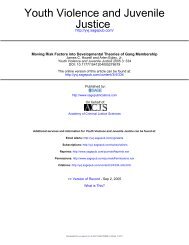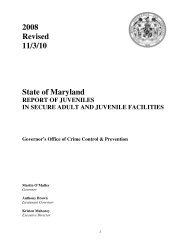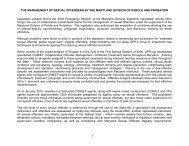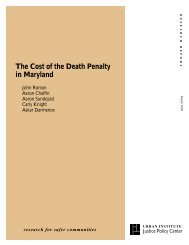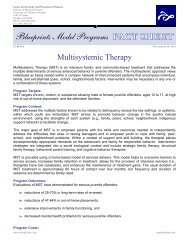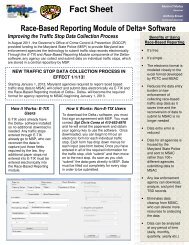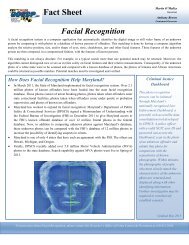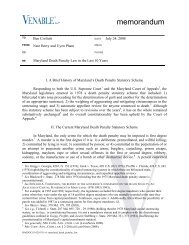Targeted Outreach - Governor's Office of Crime Control & Prevention ...
Targeted Outreach - Governor's Office of Crime Control & Prevention ...
Targeted Outreach - Governor's Office of Crime Control & Prevention ...
Create successful ePaper yourself
Turn your PDF publications into a flip-book with our unique Google optimized e-Paper software.
52 <strong>Targeted</strong> <strong>Outreach</strong><br />
into city recreation facilities and the use <strong>of</strong> other non-Club<br />
facilities to run the Comin’ Up program around the city in<br />
the evening hours. The program also implemented a new<br />
practice by checking to see that no youth brought weapons<br />
into the Club.<br />
Boys & Girls Club <strong>of</strong> Ventura: “Facing the Future”<br />
Project Overview<br />
In Ventura, the gang intervention initiative is called<br />
“Facing the Future.” With a few exceptions, Facing the<br />
Future (FtF) youth are probation referrals and attend the<br />
Clubs as a “loose” condition <strong>of</strong> their probation. The youth<br />
are responsible for attending FtF for a total <strong>of</strong> 50 hours,<br />
and the ideal is to have youth participate in programming<br />
at the Club twice a week for 12 consecutive weeks.<br />
However, if youth miss a day, they simply attend for longer<br />
than 12 weeks. Program plans are developed according to<br />
a 12-week schedule, but because the FtF operates on a continuous<br />
basis, youth simply begin or finish attending<br />
classes according to their own schedule. Programming<br />
includes biweekly sessions that cover conflict resolution,<br />
job search assistance, team building activities, homework<br />
assistance, and recreational activities and field trips.<br />
Goals<br />
Almost everyone we spoke with felt that it was unrealistic<br />
to try to get youth out <strong>of</strong> gangs. Instead, they established a<br />
goal <strong>of</strong> having the youth living positive lifestyles, “facing<br />
the future in a way they had not done before,” though they<br />
may continue to verbally “claim” a gang. The adults<br />
seemed to understand that the gang represents a neighborhood<br />
or ethnic identity and not necessarily a criminal<br />
lifestyle. A “positive” lifestyle includes employment, no<br />
criminal activity and relationship development (mentoring,<br />
parenting, anger management).<br />
Gang Problem<br />
The gang problem in Ventura is reportedly a reflection <strong>of</strong><br />
the gang problem in Southern California. Although<br />
police feel the gang situation in Ventura is not as serious a<br />
problem when compared to Los Angeles or neighboring<br />
Oxnard, they report a “significant number” <strong>of</strong> gangrelated<br />
crimes, including stabbings, beatings, vandalism,<br />
substance abuse, some drug dealing and a few homicides.<br />
Police estimate that there are approximately 1,000 gang<br />
members in Ventura, with eight gang killings that took<br />
place between July 1997 and June 1998, an increase from<br />
the previous year. Several people we talked to mentioned<br />
that, although most <strong>of</strong> the Ventura gangs (like the Avenue<br />
Gangsters) are Hispanic, the number <strong>of</strong> white supremacist<br />
gangs is growing. In fact, the Club was closed down for<br />
several months because <strong>of</strong> a fire allegedly set by a white<br />
supremacist youth. A few people also mentioned the influence<br />
<strong>of</strong> the Hell’s Angels, which they claim encourages<br />
white supremacist groups and brings drugs (mainly<br />
methadone) into communities.<br />
History and Development <strong>of</strong> the Initiative<br />
Fifteen years ago, Ventura was shocked by its first drive-by<br />
shooting. As a result <strong>of</strong> the drive-by, the then police chief<br />
started a gang enforcement team. The unit was exclusively<br />
concerned with enforcement and making a pro-active<br />
statement to the community.<br />
In 1992, a Gang Taskforce committee was formed, and a<br />
Boys & Girls Clubs unit director was one <strong>of</strong> the co-chairs.<br />
The taskforce included citizens, police and representatives<br />
<strong>of</strong> the department <strong>of</strong> drug and alcohol abuse. Out <strong>of</strong> this<br />
taskforce came the Youth Violence <strong>Prevention</strong> Committee.<br />
Over the next few years, this group spearheaded a community<br />
mobilization effort, put together plans for the area’s<br />
first youth summit and developed master plans for the city<br />
to reduce youth violence.<br />
In 1994, a group <strong>of</strong> people who were involved with the taskforce,<br />
including the judge, Club staff and some police, went<br />
to an OJJDP conference. Following the conference, Boys &<br />
Girls Club <strong>of</strong> Ventura applied to BGCA for a GITTO grant.<br />
Representatives from police and probation worked with the<br />
Club’s executive director and the Club project director to<br />
develop the structure <strong>of</strong> FtF, using Boys & Girls Clubs <strong>of</strong><br />
America’s four-point philosophy as a foundation.<br />
The project was implemented in two Club units: Addison<br />
and LeFevre.<br />
Recruitment Process and Referral Partners<br />
The recruitment and referral efforts differ for the two<br />
Club units. One unit, Addison, receives all <strong>of</strong> its referrals<br />
from probation. After probation <strong>of</strong>ficers review their caseloads,<br />
FtF program directors help them decide which<br />
youth to refer. The youth referred to the LeFevre unit also<br />
include referrals from other agencies (e.g., the Westside<br />
Family Center, an agency that deals primarily with domestic<br />
violence problems, but with a focus on the emotional<br />
needs <strong>of</strong> at-risk family and youth) and members <strong>of</strong> the<br />
Club’s alternative high school program (whose youth are<br />
referred by the school district).<br />
Staffing, Intake and Tracking Process<br />
Youth referred through probation learn about FtF. On<br />
their first night at the Club, the youth along with his or<br />
her parent, the probation <strong>of</strong>ficer, all FtF staff and a police<br />
<strong>of</strong>ficer attend an orientation session. If the youth completes<br />
the program, the same group is invited back to celebrate.<br />
The probation <strong>of</strong>ficer indicated, however, that half<br />
<strong>of</strong> the time the youth’s parents do not show up.






